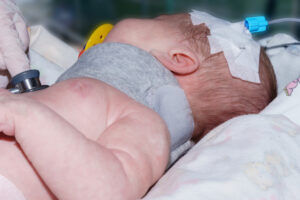How do babies breathe in the womb, and how do they become oxygen-deprived?
Babies do not exactly “breathe” in the womb; at least not by inhaling air they way they do after delivery. Instead, oxygen travels through the mother’s lungs, heart, vasculature, uterus, and placenta, finally making its way through the umbilical cord and into the fetus.
Interruptions in the Oxygen Pathway: Birth Injuries
During labor and delivery, oxygen supply to the fetus can be dangerously reduced, or cut off entirely. This can result in birth injuries such as hypoxic-ischemic encephalopathy and cerebral palsy, among many others. Although fetal oxygen deprivation resulting in birth injuries can theoretically stem from an interruption anywhere along the oxygen pathway, the issue is generally in one of the final three steps: uterus, placenta, or umbilical cord. To better understand how oxygen transmission works in the womb of a healthy pregnancy, and what could potentially go wrong at each stage of the process, read through this step-by-step summary:
Oxygen Pathway Interruption in the Mother’s Uterus
To get to the placenta, oxygenated blood travels through the arcuate, radial, and spiral arteries. The most common cause of oxygen flow interruption in the uterus is pressure on blood vessels from uterine hyperstimulation and excessively strong contractions. This can be caused by improper use of Pitocin. Uterine rupture can also be a serious threat to the health of the mother and baby. This most often happens during vaginal birth after cesarean (VBAC), but can also result from Pitocin misuse.
Oxygen Pathway Interruption in the Placenta
Oxygenated blood leaves the spiral arteries of the uterus and is deposited in the intervillous space of the placenta. The maternal hemoglobin then releases oxygen, so it can diffuse across the placental blood-blood barrier and bind to fetal hemoglobin.
A number of conditions and complications may interfere with oxygen transfer across the placenta. Some, involving the smallest blood vessels, may not be detected until a histopathologic examination (microscopic examination of tissue) is conducted after delivery. Other causes are typically easier to detect, and should be managed properly by medical professionals. These causes include:
Once oxygen has entered the fetal side of the blood-blood barrier, there are other conditions that can interrupt transfer. Some examples are:
- Fetal anemia
- Hemoglobinopathy (abnormal hemoglobin structure)
- Viral infections such as parvovirus
- Fetal-maternal hemorrhage
- Glucose-6-phosphate dehydrogenase (G6PD)
Oxygen Pathway Interruption in the Umbilical Cord
 From the placenta, the oxygenated fetal blood enters the umbilical cord, and from there, travels directly into the fetus. Umbilical cord issues can sometimes be seen early through the use of an ultrasound, or may become apparent during labor and delivery. Oxygen interruption in the umbilical cord can result from:
From the placenta, the oxygenated fetal blood enters the umbilical cord, and from there, travels directly into the fetus. Umbilical cord issues can sometimes be seen early through the use of an ultrasound, or may become apparent during labor and delivery. Oxygen interruption in the umbilical cord can result from:
- Nuchal cord
- Cord prolapse and compression
- Infection and inflammation
- Vasa previa
For more information on umbilical cord problems leading to birth injury, click here.
Conclusion
The pathway that oxygen must travel to get from the outside world to a growing fetus is long and intricate. At any point along this pathway, things can go wrong, but birth injuries are most commonly caused by interruptions that involve the uterus, placenta, and umbilical cord. However, with swift and appropriate medical intervention, serious harm to the mother and/or baby can often be avoided.
The information presented above is intended only to be a general educational resource. It is not intended to be (and should not be interpreted as) medical advice. If you have questions about how to manage or treat a medical condition, please consult with a medical professional.
Legal Help for Birth Injuries due to Oxygen Deprivation

A number of medical mistakes and deviations from care standards can cause a fetus’s oxygen supply to be compromised, potentially leading to serious birth injuries such as hypoxic-ischemic encephalopathy and cerebral palsy. If you suspect that your child suffered from oxygen deprivation as the result of medical malpractice, we encourage you to reach out to the birth injury attorneys at Reiter & Walsh ABC Law Centers: Birth Injury Lawyers for a free case review. Our attorneys exclusively handle birth injury cases, with a specific focus on conditions resulting from oxygen deprivation. Please be aware that there is a limited period of time that families can pursue birth injury cases—you may contact our legal team to determine if your loved one’s statute of limitations has expired. To start your free case review, you may contact us in the following ways:
Sources